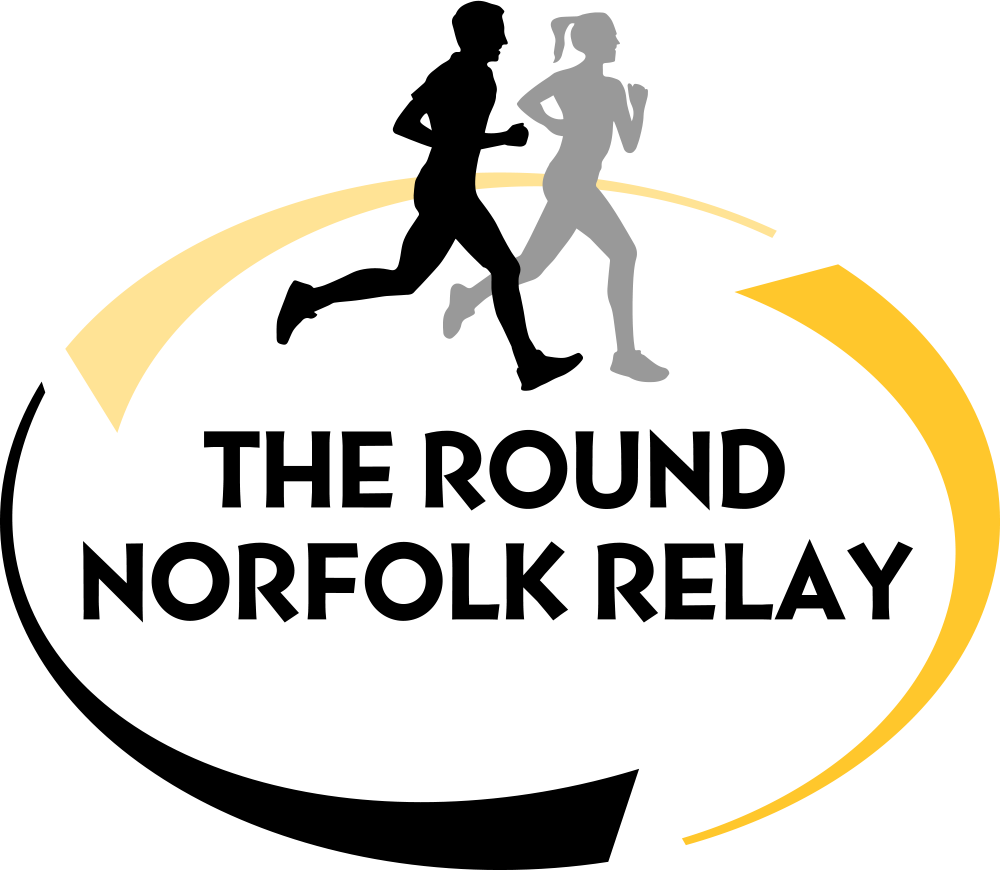
14-15th September 2024

Safety Rules for the RNR
Compliance with the race rules is mandatory for all teams and runners participating in the Round Norfolk Relay. Runners will be stopped from joining the race if not accompanied by the escort required, and are likely to be disqualified for breaching safely critical rules. Serious or repeated infringement of safety rules may result in team disqualification.
General Safety Rules
- G1: All competitors, officials, spectators and other participants must observe the Highway Code.
- G2: All runners must be escorted by a pedal cyclist during daylight hours 6:45-19:00 (except off-road sections on stages 1-4 where cycles are not permitted, and between points 5u and 5v on stage 5). This is a safety critical rule.
- G3: All runners must be escorted by a vehicle outside daylight hours (19:00-06:45 or longer in the event of adverse weather or as otherwise instructed by the Race Director or Chief Referee). This is a safety critical rule.
- G4: Changeover zones shall extend 10 metres either side of the stage start line. This zone must be kept clear of vehicles at all times.
- G5: No-one has the power to direct traffic except a police officer.
- G6: All participants are responsible for reading and obeying all safety rules and instructions which apply to them.
- G7: Report any incidents, accidents and near misses to the marshals who will report them to the Race Director.
- G8: No participants may trespass on private land (e.g. Feltwell Golf Club).
Safety Rules for Runners
- R1: All runners must wear a hi-viz bib with reflective strips (the RNR mandatory standard is EN ISO 20471 (formerly EN471)) at all times on all stages. The bib must be worn over the runner's shirt/club shirt and any hydration pack or vest. Non-compliance will be automatically penalised by a DNS penalty for that stage and may result in disqualification. There will be no warnings and no appeals. This is a safety critical rule.
- R2: All runners must run with (and not against) the traffic while running on roads, keeping well to the left hand side of the road and must not take any shortcuts on any roundabouts. Use pavements and footpaths where possible.
- R3: All runners must carry a charged and functional mobile phone while running the off-road stages without an escort, with emergency numbers programmed into contacts. This is a safety critical rule.
- R4: A runner's race number must be clearly visible from the front. The race number should be attached to the runner's reflective bib, and not to their vest beneath or to a shared or separate band.
- R5: Each runner's emergency and medical information must be completed on the reverse of their race number. This is a safety critical rule.
- R6: Runners must obey all race instructions issued by race marshals and officials.
- R7: Personal audio devices (including bone conducting headphones) must not be worn during the race. This is a safety critical rule.
- R8: Runners must remain vigilant at stage changeovers, and remain aware of traffic, pedestrians, adverse ground conditions, animals and overhanging foliage.
- R9: Runners must abide by road and course signage and signals including at railway crossings.
- R10: Runners must inform their team leader of any pre-existing medical conditions in advance of starting their stage, including but not limited to impaired sight or hearing.
- R11: Runners must familiarise themselves fully with their course/stage and be aware of highlighted special hazards.
- R12: Runners should dress appropriately for the prevailing weather conditions.
- R13: Runners should ensure they are properly hydrated and fuelled.
- R14: Except when overtaking another team, runners must not leave their escort cyclist or vehicle.
- R15: When approaching a slower moving race vehicle, runners should be confident that they have been seen, and we recommend that runners undertake such vehicles. Please read and follow the RNR Passing Protocol below.
- R16: Runners are strongly advised to wear and use a head torch or chest light outside daylight hours (19:00-06:45). Stage 1 runners running outside daylight hours are also advised to use a head torch or appropriate chest light on all off-road sections.
Safety Rules for Escort Vehicles
- V1: All escort vehicles must display a team number clearly visible from the rear at all times, and not obscured by tinted glass. If the number cannot be read under tinted glass it should be fixed onto the exterior of the vehicle.
- V2: Always drive directly behind your runner. Do not leave your runner alone.
- V3: All escort vehicles must be fitted with an independent amber flashing beacon light attached to the roof. Ensure that the beacon light is of good quality, clearly visible, and located at the rear of the roof not the front. See also Rule V6 below regarding carrying a spare beacon light. Use of hazard warning lights instead is not permitted. This is a safety critical rule.
- V4: Escort vehicles must also display the RNR issued 'Road Runner In Front' warning sign on the rear of the vehicle. The warning sign must be clearly visible from the rear at all times and not obscured by tinted glass. If the sign cannot be read under tinted glass it should be fixed onto the exterior of the vehicle. This is a safety critical rule.
- V5: Wear high-visibility clothing when exiting from the vehicle.
- V6: Escort vehicles must carry a first aid kit, a functioning spare amber flashing beacon light, spare bicycle lights and a functioning mobile phone.
- V7: When overtaking slower teams allow your runner to pass the other escort vehicle and runner only when it is safe and clear to do so. All runners and escorts should follow the Passing Protocol set out below.
- V8: Escort vehicles must obey the Highway Code.
- V9: Escort vehicles should be aware of the course route and carry the course stage descriptions and maps on board, either in hardcopy form or downloaded in advance from the RNR website onto a functional device.
- V10: Escort drivers should ensure adequate rest breaks and should not drive whilst tired.
- V11: Spot checks may be carried out to ensure compliance with rules V1 to V4.
- V12: Be aware of runners undertaking your vehicle.
- V13: Do not use hazard warning lights whilst moving.
Safety Rules for Escort Cyclists
- C1: Cyclists must display a team number visible from the rear.
- C2: Cyclists must ride behind their runner and must not pace the runner.
- C3: Cyclists must wear hi-viz and reflective items (RNR mandatory standard is EN ISO 20471). This is a safety critical rule.
- C4: Cyclists must use functioning front and rear lights when cycling during the hours of darkness. This is a safety critical rule.
- C5: Cyclists must carry a functional mobile phone.
- C6: Cyclists must be accompanied by an escort vehicle during the hours of darkness. For the avoidance of doubt, the use of an escort vehicle is mandatory outside daylight hours (as defined in rule G3 above). Use of a cycle escort as well as the escort vehicle is permitted and encouraged during the hours of darkness, but a cyclist cannot take the place of the mandatory escort vehicle. This is a safety critical rule.
- C7: Cyclists must obey the Highway Code.
- C8: Cyclists should be familiar with the course stage and have access to the stage description and map.
- C9: Cycles must be roadworthy.
- C10: Cycle helmets must be worn.
Safety Critical Incidents
The rules applicable to safety critical incidents include but are not limited to G2, G3, R1, R3, R5, R7, V3, C3, C4 and C6. Where breaches of safety critical rules are observed by a marshal, referee or other race official, and a verbal warning is ignored, the breach should be reported to the Race Director immediately who in addition to any other penalties imposed may disqualify the team concerned from the race in progress, or from the following year's race.
Safety rules last updated: 14/9/2023
RNR Passing Protocol
When approaching a slower-moving runner and escort vehicle (and cyclist if one is present) with the intention of passing them the following protocol should be observed, particularly on main roads during the hours of darkness:
The escort vehicle of a runner/team about to be overtaken should move slightly out to the right, away from the kerb, in order to create a notional ‘corridor’ for the faster runner (and cyclist if one is present) to overtake on the inside. Thus the faster runner will in fact be ‘undertaking’ the team/vehicle in front, remaining on the left and close to the side of the road.
After the faster runner (and their cyclist if one is present) has emerged from the corridor and moved ahead, the slower escort vehicle should then move back in towards the kerb, having first checked that it is safe to do so.
Meanwhile, the escort vehicle accompanying the faster runner should remain behind the slower vehicle until such time as a suitable gap had opened up in front of the slower vehicle. Then – and only then – the faster vehicle should seek to overtake the slower runner and their vehicle.
In summary, faster runners and their cyclists should always undertake slower teams, staying to the left. The vehicle accompanying the faster runner should always overtake the slower team, passing them on the right.
Slower vehicles should not doggedly hug the kerb, thereby preventing faster runners from overtaking in safety on the nearside. Faster runners overtaking on the offside of slower vehicles place themselves at risk of running into the path of oncoming traffic as well as traffic overtaking from behind.